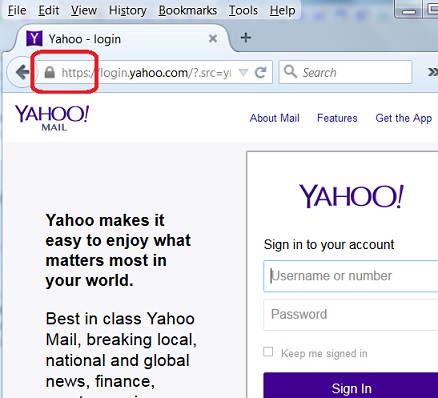PKI Tutorials - Herong's Tutorial Examples - v2.32, by Herong Yang
Visiting "https" Website with Mozilla Firefox
This section describes how Mozilla Firefox shows a lock icon when you visit an 'https' Website to provide you more security related information.
As I mentioned earlier in the book, Web browsers play very important roles in using HTTPS (Hypertext Transfer Protocol Secure) to secure Web communications. Now let's see how Mozilla Firefox, as the leading Web browser, supports HTTPS.
1. Run Mozilla Firefox and go to Yahoo home page, www.yahoo.com.
2. Click "Mail" in the Yahoo Sites menu.
3. After Mozilla Firefox finishing displaying the login page, look at the bottom right corner of the browser window. You will see lock icon displayed next to the address:

What happened here was:
- When the link "Mail" was clicked, Firefox was redirected to use this URL: https://login.yahoo.com/...
- Since this is HTTPS based URL, Firefox requested for the server, login.yahoo.com, to provide the server certificate.
- Firefox validated the server certificate and found no issue.
- Firefox created a one-time encryption key, encrypted with server's public key and delivered to the server.
- Server returned the login page document encrypted with the encryption key.
The lock icon at the right side of the address indicates that this page is secured with HTTPS. If you click the lock icon, Firefox will provide you more security related information for this page. See next sections for more tutorials.
Table of Contents
Introduction of PKI (Public Key Infrastructure)
Introduction of HTTPS (Hypertext Transfer Protocol Secure)
Using HTTPS with Google Chrome
►Using HTTPS with Mozilla Firefox
►Visiting "https" Website with Mozilla Firefox
Viewing Server Certificate in Mozilla Firefox
Server Certificate General Information
Viewing Server Certificate Path in Mozilla Firefox
Exporting Server Certificate to File in Mozilla Firefox
Viewing Pre-Installed Certificates in Mozilla Firefox
Listing of Trusted Root CA in Mozilla Firefox
Exporting Certificate to File from Mozilla Firefox
Deleting Root CA Certificates from Mozilla Firefox
Mozilla Firefox Displaying Certificate Error Page
Adding Security Exception in Mozilla Firefox
Failing to Import Root CA Certificates to Mozilla Firefox
Certificate Trust Settings in Mozilla Firefox
HTTPS with IE (Internet Explorer)
Android and Server Certificate
Windows Certificate Stores and Console
RDP (Remote Desktop Protocol) and Server Certificate
macOS Certificate Stores and Keychain Access
Perl Scripts Communicating with HTTPS Servers
PHP Scripts Communicating with HTTPS Servers
Java Programs Communicating with HTTPS Servers
.NET Programs Communicating with HTTPS Servers
CAcert.org - Root CA Offering Free Certificates
PKI CA Administration - Issuing Certificates
Comodo Free Personal Certificate
Digital Signature - Microsoft Word
Digital Signature - OpenOffice.org 3